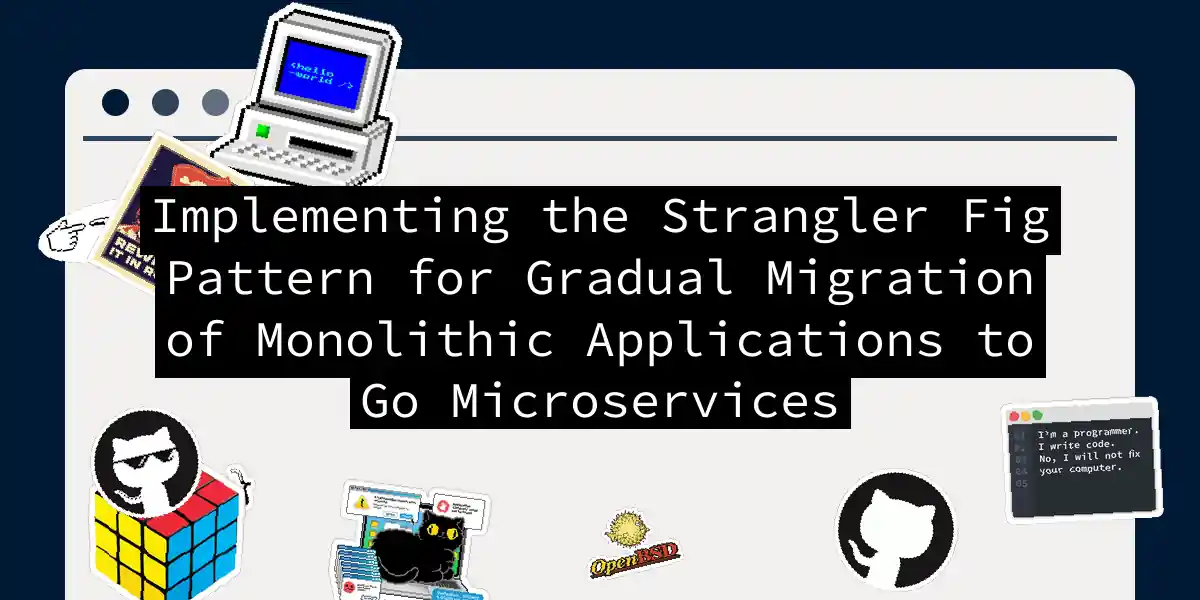The Strangler Fig Pattern: A Gentle Giant in Migration
Imagine a tree, once robust and solitary, now being slowly enveloped by a strangler fig. This natural phenomenon is a perfect metaphor for the software development world, particularly when migrating from a monolithic application to a microservices architecture. The Strangler Fig pattern, articulated by Martin Fowler, is a methodical and risk-averse approach to this migration, ensuring that the transition is as smooth as a summer breeze.
Why the Strangler Fig Pattern?
Migrating a monolithic application to microservices is not a trivial task. It’s akin to trying to replace the wheels of a moving car without stopping it. The Strangler Fig pattern offers a way to achieve this feat gradually, minimizing the risk of a large-scale rewrite and the associated downtime.
Here’s a step-by-step guide on how to implement this pattern, infused with a bit of humor and practical insights.
Step 1: Identify and Isolate
The first step is to identify a module or a set of APIs within your monolithic application that you want to replace with a microservice. Let’s call this module “A.” Think of module A as the first branch of the tree that the strangler fig will start to wrap around.
Step 2: Transform and Coexist
Once you’ve identified module A, you need to transform it into a microservice. This involves creating a new service that replicates the functionality of module A. Here’s where the magic happens:
- Change Data Capture (CDC): Use CDC to capture any changes to module A’s data and convert them into an event stream. This stream will feed your new microservice, ensuring it stays in sync with the monolith[1][3][5].
- Proxy Setup: Place a proxy between the monolith and its clients. Route all read calls to module A to your new microservice. This way, the clients remain oblivious to the change, and you can test your microservice in a real-world scenario without disrupting the entire system[1][3][5].
Step 3: Handle Writes and Stream Back
As your microservice matures, it’s time to handle write operations. Update the proxy to route all write calls to module A to your microservice. To keep the monolith in sync, use CDC again to stream changes back to the monolith. This ensures that the monolith remains functional and unaware of the changes happening around it[1][3][5].
Step 4: Eliminate the Old
As more modules are migrated, the monolith gradually loses its functionality. Once all critical modules have been replaced, it’s time to say goodbye to the old monolith. This is the final step where you eliminate the monolithic application, leaving only your shiny new microservices in place[1][3][5].
Practical Example with Go
Let’s take a simple example using Go to illustrate this process. Suppose we have a monolithic e-commerce application with a module for handling orders.
Step 1: Identify and Isolate
Identify the order module within the monolith.
// Monolithic Application
package main
import (
"fmt"
"net/http"
)
func handleOrder(w http.ResponseWriter, r *http.Request) {
// Order handling logic
fmt.Fprint(w, "Order handled by monolith")
}
func main() {
http.HandleFunc("/order", handleOrder)
http.ListenAndServe(":8080", nil)
}
Step 2: Transform and Coexist
Create a new Go microservice for handling orders.
// Microservice for Orders
package main
import (
"fmt"
"net/http"
)
func handleOrder(w http.ResponseWriter, r *http.Request) {
// Order handling logic in microservice
fmt.Fprint(w, "Order handled by microservice")
}
func main() {
http.HandleFunc("/order", handleOrder)
http.ListenAndServe(":8081", nil)
}
Set up a proxy to route requests to the microservice.
// Proxy Server
package main
import (
"fmt"
"net/http"
"net/http/httputil"
"net/url"
)
func main() {
// Set up proxy for read requests
proxy := httputil.NewSingleHostReverseProxy(&url.URL{Scheme: "http", Host: "localhost:8081"})
http.Handle("/order", proxy)
http.ListenAndServe(":8080", nil)
}
Step 3: Handle Writes and Stream Back
Update the proxy to handle write requests and use CDC to stream changes back to the monolith.
// Updated Proxy Server
package main
import (
"fmt"
"net/http"
"net/http/httputil"
"net/url"
)
func main() {
// Set up proxy for write requests
proxy := httputil.NewSingleHostReverseProxy(&url.URL{Scheme: "http", Host: "localhost:8081"})
http.Handle("/order", proxy)
http.ListenAndServe(":8080", nil)
}
// CDC Stream Back (simplified example)
func streamChangesBack() {
// Simulate CDC streaming changes back to monolith
fmt.Println("Streaming changes back to monolith")
}
Advantages and Considerations
The Strangler Fig pattern offers several advantages:
- Gradual Migration: Reduces the risk associated with a big-bang rewrite.
- Minimal Disruption: Ensures that the system remains functional during the migration process.
- Flexibility: Allows for the addition of new features without waiting for the entire transformation to be complete[1][3][5].
However, it also comes with some considerations:
- Complexity: Managing both the monolith and microservices in parallel can be complex.
- Resource Intensive: Requires significant resources and infrastructure changes.
- Team Expertise: Needs a team experienced in distributed systems and DevOps practices[2][4].
Conclusion
Migrating a monolithic application to microservices is a journey, not a destination. The Strangler Fig pattern is your trusted guide on this journey, ensuring that each step is taken with precision and minimal risk. By following these steps and leveraging tools like CDC and proxies, you can transform your monolithic tree into a thriving forest of microservices.
So, the next time you’re faced with the daunting task of migration, remember the strangler fig – it’s not just a pattern, it’s a gentle giant that wraps around your monolith, slowly but surely, until it’s ready to stand on its own as a robust microservices architecture.
